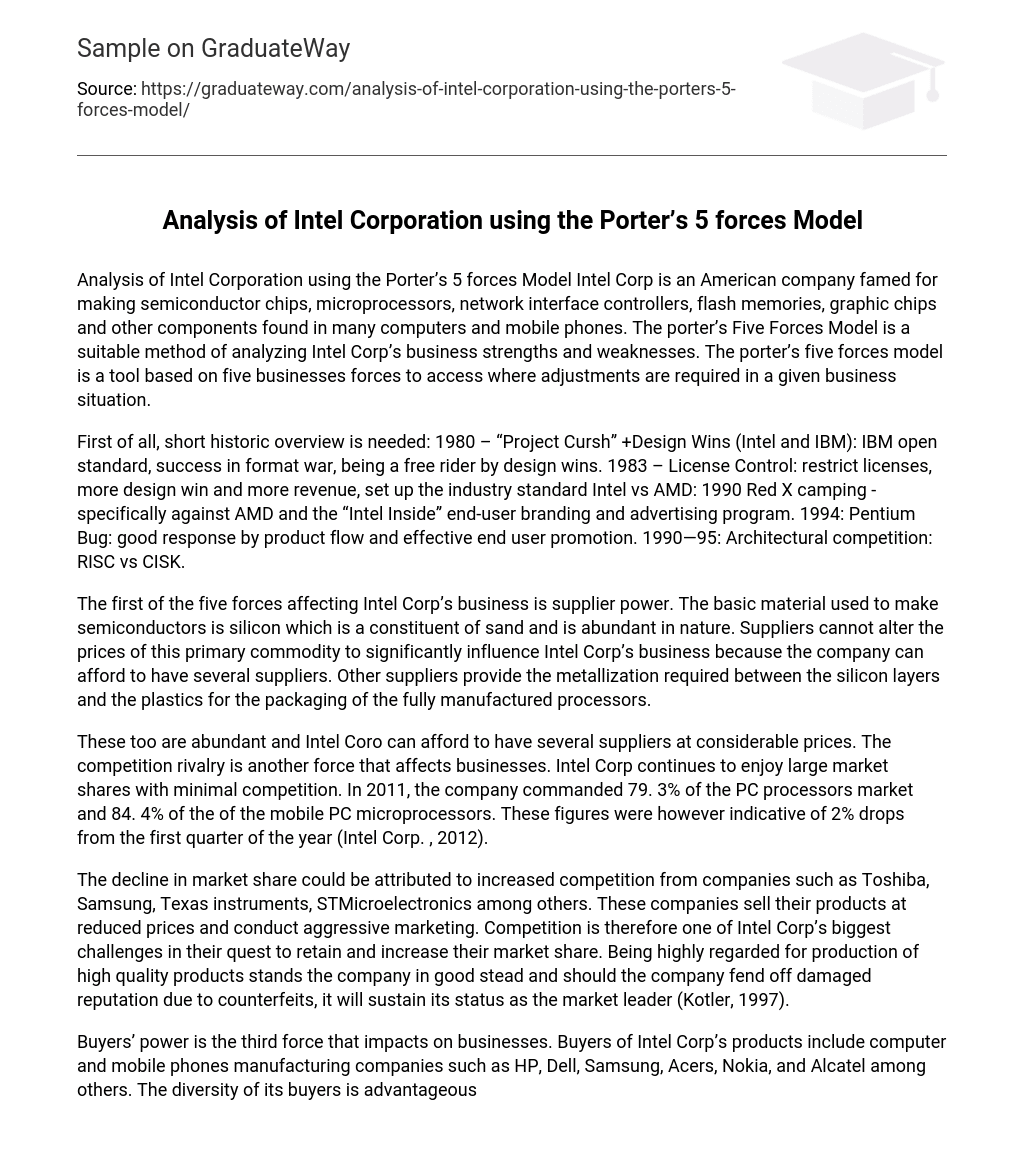Intel Corp is an American company famed for making semiconductor chips, microprocessors, network interface controllers, flash memories, graphic chips and other components found in many computers and mobile phones. The porter’s Five Forces Model is a suitable method of analyzing Intel Corp’s business strengths and weaknesses. The porter’s five forces model is a tool based on five businesses forces to access where adjustments are required in a given business situation.
First of all, short historic overview is needed:
- 1980 – “Project Cursh” +Design Wins (Intel and IBM): IBM open standard, success in format war, being a free rider by design wins.
- 1983 – License Control: restrict licenses, more design win and more revenue, set up the industry standard Intel vs AMD.
- 1990 Red X camping – specifically against AMD and the “Intel Inside” end-user branding and advertising program.
- 1994: Pentium Bug: good response by product flow and effective end user promotion.
- 1990—95: Architectural competition: RISC vs CISK.
The first of the five forces affecting Intel Corp’s business is supplier power. The basic material used to make semiconductors is silicon which is a constituent of sand and is abundant in nature. Suppliers cannot alter the prices of this primary commodity to significantly influence Intel Corp’s business because the company can afford to have several suppliers. Other suppliers provide the metallization required between the silicon layers and the plastics for the packaging of the fully manufactured processors.
These too are abundant and Intel Coro can afford to have several suppliers at considerable prices. The competition rivalry is another force that affects businesses. Intel Corp continues to enjoy large market shares with minimal competition. In 2011, the company commanded 79. 3% of the PC processors market and 84. 4% of the of the mobile PC microprocessors. These figures were however indicative of 2% drops from the first quarter of the year (Intel Corp. , 2012).
The decline in market share could be attributed to increased competition from companies such as Toshiba, Samsung, Texas instruments, STMicroelectronics among others. These companies sell their products at reduced prices and conduct aggressive marketing. Competition is therefore one of Intel Corp’s biggest challenges in their quest to retain and increase their market share. Being highly regarded for production of high quality products stands the company in good stead and should the company fend off damaged reputation due to counterfeits, it will sustain its status as the market leader (Kotler, 1997).
Buyers’ power is the third force that impacts on businesses. Buyers of Intel Corp’s products include computer and mobile phones manufacturing companies such as HP, Dell, Samsung, Acers, Nokia, and Alcatel among others. The diversity of its buyers is advantageous to Intel Corp because it makes it hard for them to set or demand for their own prices. However, several of these companies such as Samsung and Toshiba are now making their own processors and can therefore demand for lower prices and set the terms of business for Intel Corp.
This is because they have several suppliers for the same products Intel Corp is providing. The fourth force affecting businesses is the threat from substitutions. Currently, computers and other technological devices are principally reliant on processors to function meaning that the threat of substitutions to Intel Corp’s business is minimal. However, recent advancements in technology could usher into the electronics market other improved devices that may become threats to the current processors.
The law force affecting Intel Corp is the threat of new entry products. In the wake of meteoric advancements on the technological front, the threat of new products to compete with Intel Corp’s products is rife. The biggest threat comes from counterfeit processors that damage the reputation and business function of Intel Corp. Intel being the market leader suffers the risk of being attractive to counterfeits who introduce “new” and ineffective products to the detriment of Intel Corp.
Intel Corp is a large company dealing in the manufacture of microprocessors for computers and mobile phones. The company is significantly challenged when subjected to Porter’s Five Forces. It can weather the influence from suppliers and the threat from substitutions. The advancements in technology, counterfeiting and expansion of companies to produce their own processors pose threats to the business in matters about buyers’ power, entry of new products and competition from other companies.





